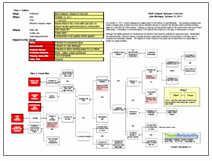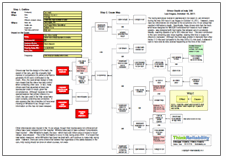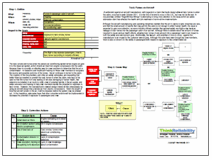On October 31, 2011, a bluff collapsed at a power plant on the shores of Lake Michigan. The resulting mudslide took trailers, storage units, at least one truck and an unknown amount of coal ash into the lake, which provides drinking water for more than 40 million people. Cleanup is ongoing, but the overall impact to the environment has not yet been determined. Fortunately, no personnel were in the objects that ended up in the lake, so there were no injures.
Although the safety goal was not impacted by this incident, there was the potential for personnel injury. Additionally, the environmental, customer service, property and labor goals were impacted by the pollution of the lake, loss of property and necessary cleanup. The causes for these impacts to the goals can be examined in a Cause Map, or visual root cause analysis.
 The mudslide which took the objects and coal ash into the lake was caused by insufficient stability of a bluff overlooking the lake. The bluff’s instability was caused by degraded ground material stability mixed with water and no vegetation. The vegetation had been removed for construction. The ground in the area had been filled with coal ash – a practice allowed in previous decades. Coal ash is less stable than soil, especially when it is exposed to water. In this case, aerial images suggest that the water seeped into the area from a high water table or from an unlined retention pond used to store storm water. Although a construction project was ongoing, an environmental impact study – which may have unearthed concerns about the stability of the area – was not considered necessary.
The mudslide which took the objects and coal ash into the lake was caused by insufficient stability of a bluff overlooking the lake. The bluff’s instability was caused by degraded ground material stability mixed with water and no vegetation. The vegetation had been removed for construction. The ground in the area had been filled with coal ash – a practice allowed in previous decades. Coal ash is less stable than soil, especially when it is exposed to water. In this case, aerial images suggest that the water seeped into the area from a high water table or from an unlined retention pond used to store storm water. Although a construction project was ongoing, an environmental impact study – which may have unearthed concerns about the stability of the area – was not considered necessary.
Steps are being taken to clean up the lake to the extent possible. However, concerns about coal ash in this area and others are prompting a review by Congress to determine how coal ash can be safely dealt with. Many say this incident suggests that stronger controls are needed.
To view the Outline and Cause Map, please click “Download PDF” above. Or click here to read more.









